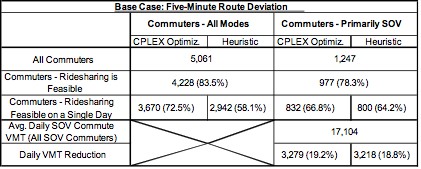
There are a number of important insights that follow from this analysis. To begin, the percentage of the MIT community that can feasibly share rides is very high. Depending on the driver deviation assumptions, between 70% and 88% of the surveyed MIT community has the option of engaging in ridesharing. For those whose primary mode of commuting is SOV travel, approximately 49% to 92% could rideshare if they chose to do so, again depending on the driver deviation assumptions. For the “All Modes” group of commuters, 83% of drivers would have to deviate less than two (2) miles.
On a daily basis, approximately 50% to 77% of the MIT Community could rideshare depending on the model assumptions. This is substantially higher than the current share of the community that chooses to rideshare (8.2%). In terms of VMT reduction potential, the model suggests that 9% to 27% of daily, commuter-based VMT could be reduced through choosing to rideshare, with a ‘base-case’ estimate of a 19% daily reduction in VMT.
Finally, from a methodological standpoint, it is interesting to consider the difference between the CPLEX optimization and simple heuristic approaches to identifying the feasible rideshare pairs on a single day. In terms of the maximization of pairings, one can clearly see that larger datasets favor the optimization approach. For smaller datasets, the difference between the two approaches is less pronounced. For the determination of VMT savings, the two approaches yield remarkably similar results.